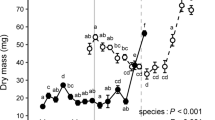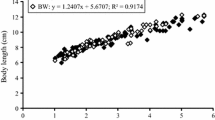Abstract
Smolting salmonids typically require weeks to months of physiological preparation in freshwater (FW) before entering seawater (SW). Remarkably, pink salmon (Oncorhynchus gorbuscha) enter SW directly following yolk absorption and gravel emergence at a size of 0.2 g. To survive this exceptional SW migration, pink salmon were hypothesized to develop hypo-osmoregulatory abilities prior to yolk absorption and emergence. To test this, alevins (pre-yolk absorption) and fry (post-yolk absorption) were transferred from FW in darkness to SW under simulated natural photoperiod (SNP). Ionoregulatory status was assessed at 0, 1 and 5 days post-transfer. SW alevins showed no evidence of hypo-osmoregulation, marked by significant water loss and no increase in gill Na+/K+-ATPase (NKA) activity or Na+:K+:2Cl− cotransporter (NKCC) immunoreactive (IR) cell frequency. Conversely, fry maintained water balance, upregulated gill NKA activity by 50 %, increased the NKA α1b/α1a mRNA expression ratio by sixfold and increased NKCC IR cell frequency. We also provide the first evidence of photoperiod-triggered smoltification in pink salmon, as fry exposed to SNP in FW exhibited preparatory changes in gill NKA activity and α1 subunit expression similar to fry exposed to SNP in SW. Interestingly, fry incurred larger increases in whole body Na+ than alevins following both SW and FW + SNP exposure (40 and 20 % in fry vs. 0 % in alevins). The ability to incur and tolerate large ion loads may underlie a novel mechanism for maintaining water balance in SW prior to completing hypo-osmoregulatory development. We propose that pink salmon represent a new form of anadromy termed “precocious anadromy”.






Similar content being viewed by others
References
Black VS (1951) Changes in body chloride, density, and water content of chum (Oncorhynchus keta) and coho (O. kisutch) salmon fry when transferred from fresh water to sea water. J Fish Res Board Can 8:164–177
Blackburn J, Clarke WC (1987) Revised procedure for the 24 hour seawater challenge test to measure seawater adaptability of juvenile salmonids. Can Tech Rep Fish Aquat Sci 1515:1–35
Boeuf G (1993) Salmonid smolting: a pre-adaptation to the oceanic environment. In: Rankin JC, Jensen FB (eds) Fish ecophysiology. Chapman Press, London, pp 105–135
Boeuf G, Harache Y (1982) Criteria for adaptation of salmonids to high salinity seawater in France. Aquaculture 28:163
Boeuf G, Harache Y (1984) Adaptation osmotique a l’eau de mer de differentes especes (Salmo trutta, Salmo gairdneri, Salvelinus fontinalis) et hybride (Salmo trutta ♀ × Salvelinus fontinalis ♂) de salmonides. Aquaculture 40:343–358
Brauer EP (1982) The photoperiod control of coho salmon smoltification. Aquaculture 28:105–111
Brown D, Breton B (1996) Mitochondria-rich, proton-secreting epithelial cells. J Exp Biol 199:2345–2358
Bystriansky JS, Richards JG, Schulte PM, Ballantyne JS (2006) Reciprocal expression of gill Na+, K+-ATPase α-subunit isoforms α1a and α1b during seawater acclimation of three salmonid fishes which vary in their salinity tolerance. J Exp Biol 209:1848–1858
Bystriansky JS, Frick NT, Richards JG, Schulte PM, Ballantyne JS (2007) Failure to up-regulate gill Na+, K+-ATPase a-subunit isoform a1b may limit seawater tolerance of land-locked Arctic char (Salvelinus alpinus). Comp Biochem Physiol A 148:332–338
Clarke WC (1982) Evaluation of the seawater challenge test as an index of marine survival. Aquaculture 28:177–183
Clarke WC, Blackburn J (1977) A seawater challenge test to measure smolting of juvenile salmon. Can Fish Mar Serv Tech Rep 705:11
Collie NL, Bern HA (1982) Changes in intestinal fluid transport associated with smoltification and seawater adaptation in coho salmon, Oncorhynchus kisutch (Walbaum). J Fish Biol 21:337–348
Dickhoff WW, Sullivan CV, Mahnken CVW (1985) Thyroid hormones and gill ATPase during smoltification of Atlantic salmon (Salmo salar). Aquaculture 45:376
Folmar LC, Dickhoff WW (1980) The parr-smolt transformation (smoltification) and seawater adaptation in salmonids: a review of selected literature. Aquaculture 21:1–37
Folmar LC, Dickhoff WW, Mahnken CVW, Waknitz FW (1982) Stunting and parr-reversion during smoltification of coho salmon (Oncorhynchus kisutch). Aquaculture 28:91–104
Fuentes J, Eddy FB (1996) Drinking in freshwater-adapted rainbow trout fry, Oncorhynchus mykiss (Walbaum), in response to angiotensin I, angiotensin II, angiotensin-converting enzyme inhibition, and receptor blockade. Physiol Zool 69:1555–1569
Fuentes J, Eddy FB (1997) Drinking in Atlantic salmon presmolts and smolts in response to growth hormone and salinity. Comp Biochem Physiol A 117:487–491
Gonzalez RJ, Cooper J, Head D (2005) Physiological responses to hyper-saline waters in sailfin mollies (Poecilia latipinna). Comp Biochem Physiol A 142:397–403
Grant A, Gardner M, Nendick L, Sackville M, Farrell AP, Brauner CJ (2009) Growth and ionoregulatory ontogeny of wild and hatchery-raised juvenile pink salmon (Oncorhynchus gorbuscha). Can J Zool 87:221–228
Grosell M (2006) Intestinal anion exchange in marine fish osmoregulation. J Exp Biol 209:2813–2827
Heard WR (1991) Life history of pink salmon (Oncorhynchus gorbuscha). In: Groot C, Margolis L (eds) Pacific salmon life histories. UBC Press, Vancouver, pp 119–230
Hoar WS (1976) Smolt transformation: evolution, behavior, and physiology. J Fish Res Board Can 33:1234–1252
Hoar WS (1988) The physiology of smolting salmonids. In: Hoar WS, Randall DJ (eds) Fish physiology, vol 11B. Academic Press, Waltham, pp 275–343
Honma M (1982) Studies on the sea water adaptation of pink salmon (Oncorhynchus gorbuscha) in the early stages. Sci Rep Hokkaido Fish Hatch (Jpn) 37:23–32
Kaneko T, Hasegawa S, Takagi Y, Tagawa M, Hirano T (1995) Hypoosmoregulatory ability of eyed-stage embryos of chum salmon. Mar Biol 122:165–170
Kirschner LB, Greenwald L, Sanders M (1974) On the mechanism of sodium extrusion across the irrigated gill of sea water-adapted rainbow trout (Salmo gairdneri). J Gen Physiol 64:148–165
Leray C, Colin DA, Florentz A (1981) Time course of osmotic adaptation and gill energetics of rainbow trout (Salmo gairdneri) following abrupt changes in external salinity. J Comp Physiol 144:175–181
Lin LY, Weng CF, Hwang PP (2001) Regulation of drinking rate in euryhaline tilapia larvae (Oreochromis mossambicus) during salinity challenges. Physiol Biochem Zool 72:171–177
Loretz CA, Collie NL, Richman NH, Bern HA (1982) Osmoregulatory changes accompanying smoltification in coho salmon. Aquaculture 28:67–74
Lytle C, Xu JC, Biemesderfer D, Forbush B (1995) Distribution and diversity of Na+–K+–Cl− cotransport proteins: a study with monoclonal antibodies. Am J Physiol Cell Physiol 269:1496–1505
Madsen SS, Kiilerich P, Tipsmark CK (2009) Multiplicity of expression of Na+, K+-ATPase a-subunit isoforms in the gill of Atlantic salmon (Salmo salar): cellular localisation and absolute quantification in response to salinity change. J Exp Biol 212:78–88
McCormick SD (1993) Methods for nonlethal gill biopsy and measurement of Na+, K+-ATPase activity. Can J Fish Aqua Sci 50:656–658
McCormick SD (1994) Ontogeny and evolution of salinity tolerance in anadromous salmonids: hormones and heterochrony. Estuaries Coasts 17:26–33
McCormick SD (2009) Evolution of the hormonal control of animal performance: insights from the seaward migration of salmon. Integr Comp Biol 49:408–422
McCormick SD, Naiman RJ (1984) Osmoregulation in the brook trout, Salvelinus fontinalis, II: effects of size, age and photoperiod on seawater survival and ionic regulation. Comp Biochem Physiol A 79:17–28
McCormick SD, Saunders RL (1987) Preparatory physiological adaptations for marine life of salmonids: osmoregulation, growth and metabolism. Trans Am Fish Soc 1:211–229
McCormick SD, Saunders RL, Henderson EB, Harmon PR (1987) Photoperiod control of parr–smolt transformation in Atlantic salmon (Salmo salar): changes in salinity tolerance, gill Na+, K+-ATPase activity and plasma thyroid hormones. Can J Fish Aqua Sci 44:1462–1468
Miles HM, Smith LS (1968) Ionic regulation in migrating juvenile coho salmon (Oncorhynchus kisutch). Comp Biochem Physiol 26:381–398
Namimatsu S, Ghazizadeh M, Sugisaki Y (2005) Reversing the effects of formalin fixation with citraconic anhydride and heat: a universal antigen retrieval method. J Histochem Cytochem 53:3–11
Nielsen C, Madsen SS, Björnsson BT (1999) Changes in branchial and intestinal osmoregulatory mechanisms and growth hormone levels during smolting in hatchery-reared and wild brown trout. J Fish Biol 54:799–818
Nilsen TO, Ebbesson LOE, Stefansson SO (2003) Smolting in anadromous and landlocked strains of Atlantic salmon (Salmo salar). Aquaculture 222:71–82
Nilsen TO, Ebbesson LOE, Madsen SS, McCormick SD, Andersson E, Bjornsson BT, Prunet P, Stefansson SO (2007) Differential expression of gill Na+, K+-ATPase a- and b-subunits, Na+, K+, 2Cl− cotransporter and CFTR anion channel in juvenile anadromous and landlocked Atlantic salmon Salmo salar. J Exp Biol 210:2885–2896
Otto RG (1971) Effects of salinity on the survival and growth of pre-smolt coho salmon (Oncorhychus kisutch). J Fish Res Board Can 28:343–349
Pelis RM, Zydlewski J, McCormick SD (2001) Gill Na+–K+–2Cl− cotransporter abundance and location in Atlantic salmon: effects of seawater and smolting. Am J Physiol 280:1844–1852
Prunet P, Boeuf G (1985) Plasma prolactin level during transfer of rainbow trout (Salmo gairdneri) and Atlantic salmon (Salmo salar) from fresh water to sea water. Aquaculture 45:167–176
Quinn TP, Myers KW (2004) Anadromy and the marine migrations of Pacific salmon and trout: Rounsefell revisited. Rev Fish Biol Fish 14:421
Richards JG, Semple JW, Bystriansky JS, Schulte PM (2003) Na+/K+-ATPase a-isoform switching in gills of rainbow trout (Oncorhynchus mykiss) during salinity transfer. J Exp Biol 206:4475–4486
Rounsefell GA (1958) Anadromy in North American salmonidae. US Fish Wildl Fish Bull 58:171–185
Sardella BA, Matey V, Cooper J, Gonzalez RJ, Brauner CJ (2004) Physiological, biochemical and morphological indicators of osmoregulatory stress in ‘California’ Mozambique tilapia (Oreochromis mossambicus x O. urolepis hornorum) exposed to hypersaline water. J Exp Biol 207:1399–1413
Smith HW (1930) The absorption and excretion of water and salts by marine teleosts. Am J Physiol 93:480–505
Stefansson SO, Nilsen TO, Ebbesson LOE, Wargelius A, Madsen SS, Björnsson BT, McCormick SD (2007) Molecular mechanisms of continuous light inhibition of Atlantic salmon parr-smolt transformation. Aquaculture 273:235–245
Sullivan CV, Brewer SD, Johnston GP, Dickhoff WW (1983) Plasma thyroid hormone concentrations and gill Na+, K+-ATPase activities in post-emergent pink salmon. Trans Am Fish Soc 112:825–829
Tytler P, Tatner M, Findlay C (1990) The ontogeny of drinking in the rainbow trout, Oncorhynchus mykiss (Walbaum). J Fish Biol 36:867–875
Ura K, Soyano K, Omoto N, Adachi S, Yamauchi K (1996) Localization of Na-K-ATPase in tissues of rabbit and teleosts using an antiserum directed against a partial sequence of the a-subunit. Zool Sci 13:219–227
Weisbart M (1968) Osmotic and ionic regulation in embryos, alevins, and fry of the five species of Pacific salmon. Can J Zool 46:385–397
Wilson JM, Leitão A, Gonçalves AF, Ferreira C, Reis-Santos P, Fonseca A, da Silva JM, Antunes JC, Pereira-Wilson C, Coimbra J (2007) Modulation of branchial ion transport protein expression by salinity in glass eels (Anguilla anguilla). Mar Biol 151:1633–1645
Zall DM, Fisher D, Garner MG (1956) Photometric determination of chlorides in water. Anal Chem 28:1665–1668
Acknowledgments
The authors wish to thank the Seymour River Salmon Hatchery for generously providing pink salmon to this study. The authors also extend their gratitude to Dr. Jason Bystriansky for invaluable insight and technical expertise. This research was supported by a Strategic Grant awarded to CJB and APF by the Natural Sciences and Engineering Research Council of Canada (NSERC).
Author information
Authors and Affiliations
Corresponding author
Additional information
Communicated by I. D. Hume.
Rights and permissions
About this article
Cite this article
Sackville, M., Wilson, J.M., Farrell, A.P. et al. Water balance trumps ion balance for early marine survival of juvenile pink salmon (Oncorhynchus gorbuscha). J Comp Physiol B 182, 781–792 (2012). https://doi.org/10.1007/s00360-012-0660-0
Received:
Revised:
Accepted:
Published:
Issue Date:
DOI: https://doi.org/10.1007/s00360-012-0660-0




